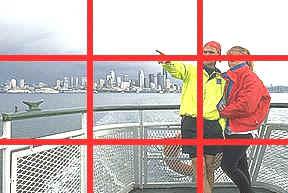|
Module 23 |
Updated: 08/13/2005 |
Elements of
Tn the next series of modules will address 15 guidelines on composition, starting with the most important of all — 1. First, clearly
establish your objectives and hold to them throughout the production.
Your objectives in doing a production may be anything from creating an
experience of pure escapism to doing a treatise on spiritual enlightenment.
"I couldn't resist it, it was such a pretty shot," is not a legitimate reason for including an extraneous scene in a production—no matter how pretty or interesting it is. At best you'll slow down the pace of the production; at worst, you'll confuse your audience by suggesting that the shot carries some special meaning that they need to keep in mind.
And speaking of slowing things down,
"slow" is commonly associated with "boring" — excuse enough to switch the channel
to try to find something more engaging. And, with dozens of channels to choose from,
there's real competition for viewer attention. In either case they will probably quickly consider other options.
If in doubt, leave it out. "But," the question is often asked,
"Isn't good production always good production, no matter how much time passes?"
Citizen Kane is considered by many film historians to be
this country's greatest film. In terms of production techniques it was far ahead
of its time. But, now, after a couple decades, its production techniques are
so behind the times that it's difficult to get a group of average people to
sit through this film. Depicting Emotional States It's in depicting emotions that we often find the greatest difficulty in determining what's relevant. Seemingly unrelated scenes of people running through stalled city traffic, lines of people pushing through turnstiles and shots of people jamming escalators might be important to establishing a frenzied state of mind in a character trying to cope with life in the city. But a shot of "a darling little girl sitting on a bench" in this sequence would not only leave the audience wondering what her role was, but would probably mislead them into believing that there is a relationship between her and the central story line. Viewers assume that every shot, gesture, and word of dialogue in a production is there to further the central idea. In other words, each shot should further the story in some way.
2. Strive
for a feeling of unity. The concept of unity applies to such things as lighting, color, wardrobes, sets, and settings. For example, you might decide to use muted colors throughout a
production to create a certain feeling or atmosphere. Or, you may want to create
an overall atmosphere by using low-key lighting together with settings that contain
earthy colors and a lot of texture. Compose Around A 3. The third guideline applies to individual scenes: compose scenes around a single center of interest. Multiple centers of interest may work in three-ring circuses where viewers are able to fully shift their interest from one event to another. But competing centers of interest within a single visual frame weaken, divide, and confuse meaning. Think of each shot as a statement. An effective written statement should
be cast around a central idea and be swept clean of anything that does not support,
explain, or in some way add to that idea.
Keep in mind also that the eye sees selectively and in three dimensions.
It tends to exclude what is not relevant at the moment. Selective Focus to the Rescue Part of the "film look" that many people like centers on selective focus, covered in an earlier module.
This was fortunate in a way. By focusing on the key element in each shot and throwing
those in front and behind that area out of focus, audiences were immediately led
to the scene's center of interest and not distracted by anything else. To make use of the creative control inherent in selective focus,
high shutter speeds, neutral density filters, or lighting control must be used.
Where There Is Light...
The eye is drawn to the brighter areas
of a scene. This means that the prudent use of lighting can be a composition tool,
in this case to emphasize important scenic elements and to de-emphasize others.
We'll see more examples of this in the modules on lighting. Shifting the Center of Interest In static composition scenes maintain
a single center of interest; in dynamic composition centers of interest can change
with time. Observe Proper Subject Placement 4.
The fourth general guideline for composition is: observe proper subject placement.
Leading the Subject Generally, when a subject is moving in a particular direction, space is provided at the side of the frame for the subject(s) to "move into." This is referred to as leading the subject. In a close-up (see below on the right) we might refer to it as "looking room."
Note that in the photo on the left above that space is allowed for the subjects to "walk into." In the photo on the right above "looking space" is provided for the woman.
Except possibly for people looking directly at the camera, it's often best to place the center of interest near one of the points indicated by the rule of thirds. In the rule of thirds the total image area is divided vertically and horizontally into three equal sections. Although it's often best to place the center of interest somewhere along the two horizontal and two vertical lines, generally composition is even stronger if the center of interest falls near one of the four cross-points illustrated in the photo on the right below. A few still cameras even have the rule of thirds gridlines visible in their viewfinders.
Note that the photos above have centers of interest consistent with the rule of thirds. Here are two more examples.
But, remember, we are speaking of a rule of thirds, not law of thirds. The rule of thirds is only a guideline—something that should be considered while composing a scene. Although composition is often stronger using the rule of thirds, many scenes (see below) "work" that do not follow this guideline.
Horizontal and Vertical Lines Weekend snapshooters also typically
go to some effort to make sure that horizon lines are perfectly centered in the
middle of the frame. This also weakens composition by splitting the frame into two
equal halves. It's generally also a good idea to break up or intersect dominant, unbroken lines with some scenic element. Otherwise, the scene may seem divided. A horizon can be broken by an object in the foreground. Often,
this can be done by simply moving the camera slightly. Here, although the horizon line is in the center of the frame, the masts of the boats break it up and keep it from dividing the frame in half. The required reading for this
module relates to an important social issue: |

 If
a good film or prize-winning photo is studied, it's generally evident that the elements
in the shot have been selected or arranged so they "pull together" to support
the basic idea. When the elements of a shot combine to support a basic visual statement,
the shot is said to have unity.
If
a good film or prize-winning photo is studied, it's generally evident that the elements
in the shot have been selected or arranged so they "pull together" to support
the basic idea. When the elements of a shot combine to support a basic visual statement,
the shot is said to have unity.  We
are not suggesting that you eliminate everything except the center of interest,
just whatever does not in some way support (or at least, does not detract from)
the central idea being presented.
We
are not suggesting that you eliminate everything except the center of interest,
just whatever does not in some way support (or at least, does not detract from)
the central idea being presented.  Early
film stocks were not highly sensitive to light, and lenses had to be used at relatively
wide apertures (f-stops) to attain sufficient exposure.
Early
film stocks were not highly sensitive to light, and lenses had to be used at relatively
wide apertures (f-stops) to attain sufficient exposure. 








 A
vertical line can be interrupted by something as simple as a tree branch.
A
vertical line can be interrupted by something as simple as a tree branch.